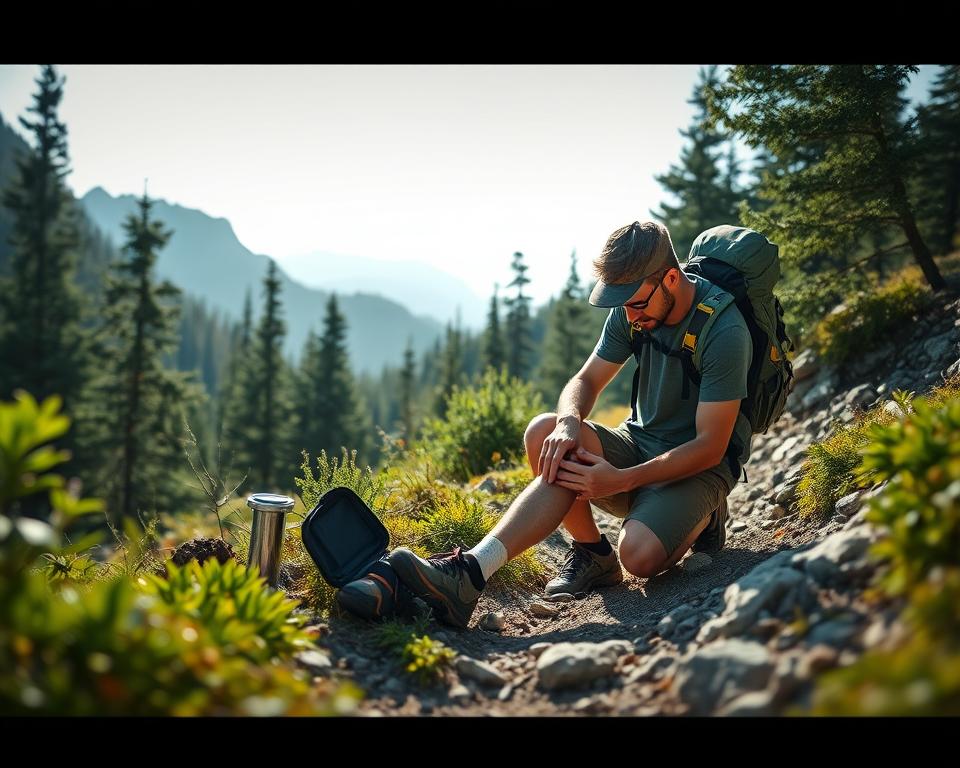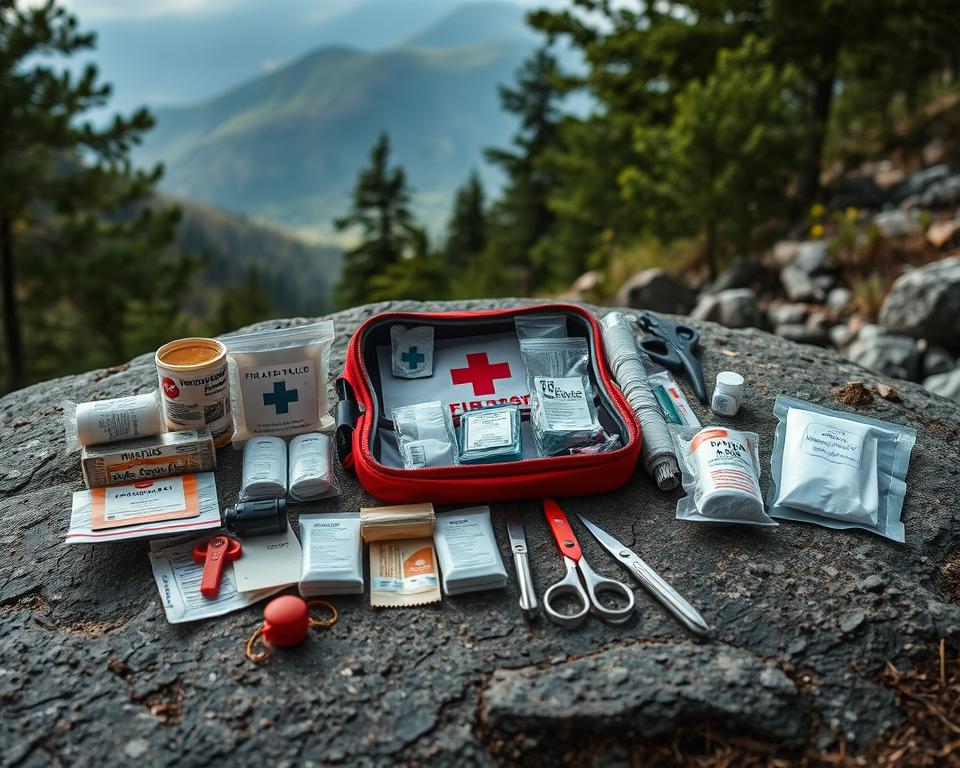When setting out for a hike, preparation is key. It’s important to have the right first aid essentials for hiking with you, whether it’s a short day trip or a longer backpacking journey. Your first aid kit should match your trip’s needs, considering things like health conditions, how far you’ll be from help, and how long you’ll be away. It’s not just about having a kit; it’s about having the right contents for your adventure.
Essentials include moleskin for blisters, bandages, and aspirin. Don’t forget personal meds like EpiPens, sunscreen, and a CPR mask. Outdoor pro Andrew Engelson says a thorough first aid kit can save lives in critical situations. Pick a brightly colored kit for quick spotting in your backpack. Whether you buy a kit like the “Be Red Cross Ready First Aid Kit (73 pc)” or make your own, the key is to have it ready and accessible.
Always check and update your first aid supplies before each trip. Make sure medications are not expired and materials are in good condition. Being prepared can turn a potential disaster into a manageable situation, making your hike safer and more enjoyable.
The Importance of a Well-Stocked First Aid Kit
A first aid kit is a must-have for outdoor adventures. It helps with small issues like cuts, bug bites, and blisters. It can also be a lifesaver in more serious situations. A good kit gives quick help and prevents things from getting worse. It buys time until you can get professional care.
The American Red Cross and experts like Andrew Engelson believe in customizing your first aid kit. It’s a key part of hiking safely. Being ready means knowing what injuries could happen and having the right tools to deal with them.
Consider a kit with 115 items, like the American Red Cross Deluxe Family First Aid Kit. It’s great for many situations. Or, the Deluxe All Purpose First Aid Kit with 299 pieces for bigger hikes. But remember, every hiker’s pack should have basics like band-aids, gauze, and cleaning wipes.
Think about dangers specific to where you’re hiking. Sudden breaks or fractures are a risk, particularly in far-off places. Customize your kit based on the trip’s length, who’s going, and where you’re headed. Always check your kit’s expiry dates and keep it away from kids.
Blisters are a common problem, especially on long or damp trails. So, add moleskin and blister care to your first aid. Heat, dehydration, and the sun are big dangers too. Include salts for rehydration. Don’t forget gloves, a CPR mask, and a blanket for protection and warmth.
For ultimate readiness, think about a first aid or wilderness training course. They cover how to handle environmental issues, fix injuries, and safely move hurt people. Training with a group helps you manage emergencies better while hiking. Safe trails start with the right first aid kit and knowing how to use it.
Basic First Aid Kit Essentials
A well-prepared hiking first aid kit is key to handling emergencies outside. It’s common to get minor injuries like cuts, blisters, and burns while hiking. Packing the right things can prevent these from turning into serious problems. Below, I’ll talk about the essentials for every hiker’s first aid kit.
Bandages and Dressings
It’s important to have lots of bandages in your kit. You’ll need adhesive bandages in different sizes, butterfly bandages for small cuts, and rolled gauze for bigger injuries. A compression bandage is also crucial for sprains. Don’t forget to pack sterile non-stick pads and medical tape. These help cover wounds and keep them safe.
Having various closure strips and sterile pads is also a good idea. They are helpful for serious injuries and ensure wounds are managed well while on the trail.
Antiseptics
Cleaning wounds properly is essential to stop infections. That’s why antiseptics are a must-have. Use antiseptic towelettes, povidone iodine, and alcohol wipes for cleansing. These prevent bacteria from growing and help wounds heal faster. If you’re going on a long hike, pack some blood-stopping gauze and cleansing pods for extra safety. Remember, using instant hand sanitizer is crucial to keep your hands clean. This reduces the risk of contaminating the wounds.
CPR Mask
A CPR mask with a one-way valve is essential for safety. If someone stops breathing, this mask protects you from germs when you give CPR. It’s small and light, so it won’t take much space in your kit. Also include a digital thermometer and an irrigation syringe for cleaning wounds. A couple of safety pins can be handy for securing bandages or making slings.
By adding these items to your hiking first aid kit, you’re ready to take on common trail injuries. This preparation increases your safety and peace of mind during your outdoor activities.
Personal Medications and Specialized Items
Putting together a personalized hiking first aid kit means including your personal meds and special gear. This way, you’re ready for any specific health issues that could come up while hiking.
Prescription Medications
Adding prescription meds to your kit isn’t just about tossing them in a bag. You should use secure and watertight containers. Also, label each medication with its dose and how to take it. Don’t forget to pack crucial meds like EpiPens for allergies or inhalers for asthma.
Make sure you pack enough medicine for the whole hike, plus a little extra. Companies like Adventure Medical Kits suggest checking your meds count before heading out.
Specialized Equipment
Your kit should also have special tools to help in emergencies. Think about adding SAM splints for broken bones, thermometers, and multitools with scissors and tweezers. These tools help deal with serious injuries or health issues in remote places.
Also, consider tools for specific threats, like snake bite kits for snake-heavy areas. Stay updated with new gadgets to make your kit even better. This approach makes your first aid kit strong and flexible for various outdoor situations.
By focusing on personalized care and packing the right health essentials and meds, you’re ensuring a safer hiking trip.
Essential First Aid Items for Hikers
Going into the wilderness means being ready for all kinds of injuries and health problems. Having a well-prepared first aid kit can help you handle a difficult situation easily. This list will help you get ready for hiking, handle pain, and avoid getting dehydrated.
Blister Treatment
Blisters can ruin a hike, but you can prevent them. Carry moleskin and adhesive bandages to treat and stop blisters. You should also have 3M Micropore Medical Tape and antiseptic wipes. These items clean and protect any blistered spots. Look into pre-packaged kits from Adventure Medical Kits for these essentials.
Pain Relief and Anti-inflammatories
When hiking tough trails, you will likely feel some pain. I always take Ibuprofen to help with pain and inflammation. About ten 200 mg tablets should be enough. Also, carry antihistamines for allergies or insect bites. Don’t forget an emergency fire starter and a small whistle for safety.
Hydration and Rehydration Salts
Staying hydrated is very important, especially on long hikes. Oral rehydration salts are crucial for keeping your electrolytes balanced. Add some rehydration solution packets to your gear. And bring hand sanitizer to keep things clean, especially before eating or treating wounds.
For longer or isolated trips, consider carrying antibiotics like Ciprofloxacin and anti-diarrheal meds. These are vital, especially in areas where you can’t easily get medical help.
For a detailed list of what you need, I suggest the first aid kit guide by the Washington Trails Association. It’s full of helpful tips.
Being prepared for hiking makes the experience better. Make sure your first aid kit has everything you need. This way, you’re ready for whatever comes your way.
Tools and Safety Equipment
Hiking is much better with the right tools and safety gear. They make your outdoor adventure smooth, not stressful. Key items include multipurpose tools and essential safety equipment. They’re not just handy; they are vital for being prepared outdoors.
Multi-Use Knife
A top tool for hiking is a strong multi-use knife. It’s crucial for minor repairs, preparing food, and emergency first aid. Whether cutting bandages or making a hiking stick, a dependable knife is key.
Tweezers and Safety Pins
Tweezers and safety pins are small but mighty for safety gear. Tweezers are great for taking out splinters or ticks that bother you during a hike. Meanwhile, safety pins can be lifesavers. They secure slings, repair ripped gear, or adjust clothes on the fly.
To sum up, these tools are key for outdoor preparedness. Choose strong, versatile, and compact tools. They will use the limited space in your pack well. And, they will keep you ready for whatever nature sends your way.
Wound Care and Infection Prevention
When you’re hiking, proper wound care and infection prevention are key. It’s important to have the right first aid supplies. You need sterile dressings, gauze, and medical tape. These items are basics for treating wounds on the trail. They help prevent infections.

Sterile Dressings and Gauze
Sterile dressings and gauze are critical for first aid. They help stop blood loss from cuts. These items come in different sizes for different wounds. It’s important to use sterile items to keep the wound clean. Having various sizes helps you be ready for anything on the trail.
Povidone Iodine and Antibiotic Ointments
Antiseptics like povidone iodine and ointments play a big role outdoors. They clean wounds to prevent infections. Adding them to your kit helps you treat wounds better. Antiseptic wipes are also great for cleaning wounds.
Don’t forget hand sanitizer and nitrile gloves in your kit. They keep things clean when treating wounds, reducing infection risk. Also, consider emergency items like fire starters and a whistle for remote areas. Taking a wilderness first aid course can also help a lot.
What Essential First Aid Items Should I Have for Hiking Trips with My Family?
When planning a hiking trip with your family, it’s crucial to pack essential first aid items. Make sure to include adhesive bandages, antiseptic wipes, and a triangular bandage. After treating any minor injuries, enjoy the day by indulging in ultimate hiking snack ideas that keep everyone energized and happy on the trail.
Conclusion
As we finish our journey into hiking first aid readiness, it’s key to see how being prepared can change our outdoor adventures. Having the basic first aid items, like bandages and specific medicines, is vital. It ensures we can handle minor injuries and bigger challenges like hypothermia or heatstroke.
It’s also crucial to understand the risks like getting lost or bumping into wildlife. A good first aid kit needs to have a mix of medicines, hydration helps, and emergency tools like whistles and flashlights. Adding personal meds and gear for allergies makes your kit fit your trip’s needs perfectly.
Checking your first aid kit regularly is a must. Make sure to look at expiration dates and refill as needed. Learning more about first aid through courses adds to your readiness. Being prepared means you can relax and enjoy your hike, knowing you’re ready for anything.
The basics of an outdoor medical kit turn risky trips into fun memories. Getting advice from local shops or doctors, especially if you have ongoing health issues or serious allergies, helps too. Being careful and ready is your ticket to a safe and happy hiking adventure.

